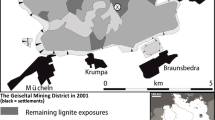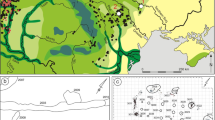Abstract
In the late spring of the year ad 1295 a landslide devastated the village of Onoldswil in the Swiss Jura mountains. During recent construction work, a small area of the original land surface was unearthed. The 5 m of compacted clay deposited by the landslide had caused the complete exclusion of oxygen and underneath it the excavators came upon mosses, blades of grasses and other plants that were still green. Below the vegetation cover the humus horizon with subterranean plant parts appeared. Samples were taken for plant macro- and microfossil and geoarchaeological analyses. This offered the rare opportunity to study the vegetation and the topsoil of a small area of land preserved in situ as an autochthonous palaeobiocoenosis, the preserved original combination of the plant community which grew there. Grassland taxa dominated the pollen and macrofossil spectra. Compacted zones within the humus horizon, the plant taxa composition and the presence of spores of coprophilous fungi showed that this place had once been a nutrient-rich pasture. Grazing animals had favoured the spread of juniper. Manuring seems to have taken place. The slopes of the surrounding mountains had been largely cleared of woodland, which may have been the cause of the landslide. The disaster probably happened in late spring, because entire fruiting capitula of Taraxacum officinale (dandelion) were found. Landslides are catastrophic events, destroying the soils and everything that lives in and on them on their way downhill. In places, however, they can also blanket the original land surface and its vegetation and create an archive of ancient life.


Reproduced by permission of swisstopo (BA16102)




Similar content being viewed by others
References
Abele G (1974) Bergstürze in den Alpen: ihre Verbreitung, Morphologie und Folgeerscheinungen. (Wissenschaftliche Alpenvereinshefte 25) Deutscher Alpenverein, München
Aeschimann D, Heitz C (2005) Index synonymique de la Flore de Suisse et territoires limitrophes (ISFS), 2ème édition. (Doc Florist Helvetiae 2) Centre du Réseau Suisse de Floristique, Genève
Beug H-J (2004) Leitfaden der Pollenbestimmung für Mitteleuropa und angrenzende Gebiete. Pfeil, München
Binggeli V, Ischi M (1997) Die Wässermatten von Melchnau. Jahrb Oberaargau 40:165–178
Bittmann F (2007) Reconstruction of the Allerød vegetation of the Neuwied Basin, western Germany, and its surroundings at 12,900 cal bp. Veget Hist Archaeobot 16:139–156
Bollinger D (2006) Der Bergsturz von Goldau 1806: Rückblick und Ausblick. Bull angewandte Geol 11:3–12
Braillard L, Guélat M, Rentzel P (2004) Effects of bears on rockshelter sediments at Tanay Sur-les-Creux, southwestern Switzerland. Geoarchaeology 19:343–367
Bullock B, Fedoroff N, Jongerius A, Stoops GJ, Tursina T (1985) Handbook for soil thin section description. Waine Research Publishers, Wolverhampton
Büntgen U, Tegel W (2014) Dendroklimatologische Beiträge zur Klimageschichte. In: Niffeler U (ed) SPM VII: Archäologie der Zeit von 800 bis 1350. Archäologie Schweiz, Basel, pp 53–57
Dengler J, Bergmeier E, Willner W, Chytrý M (2013) Towards a consistent classification of European grasslands. Appl Veg Sci 16:518–520
Ellenberg H (1988) Vegetation ecology of Central Europe. Cambridge University Press, Cambridge
Ellenberg H, Leuschner C (2010) Vegetation Mitteleuropas mit den Alpen in ökologischer, dynamischer und historischer Sicht, 6th edn. Ulmer, Stuttgart
Frahm J-P, Frey W (1992) Moosflora, 3rd edn. Ulmer, Stuttgart
Fuchs K (2014) Historischer Überblick. In: Niffeler U (ed) SPM VII: Archäologie der Zeit von 800 bis 1350. Archäologie Schweiz, Basel, pp 27–52
Gampp A, Sommerer S (2014) Der Bezirk Waldenburg. (Die Kunstdenkmäler der Schweiz 124) Gesellschaft für schweizerische Kunstgeschichte, Bern
Gobet E, Tinner W (2014) Umwelt-und Nutzungsgeschichte im Spiegel der Paläoökologie. In: Niffeler U (ed) SPM VII: Archäologie der Zeit von 800 bis 1350. Archäologie Schweiz, Basel, pp 57–62
Guélat M, Moulin B, Rentzel P (1998) Des sols enfouis dans les séquences de versant du Valais (Suisse). Caractérisation, durée des phases de pédogenèse et signification pour la chronologie régionale de l’Holocène. In: Daudry D (ed) Actes du VIIIéme Colloque International sur les Alpes dans l’Antiquité, Sion, Bullétudes préhist arch alpines. (Société Valdôtaine de Préhistoire et d’Archéologie 9) Société Valdôtaine de Préhistoire et d’Archéologie, Aoste, pp 39–52
Höft A, Müller J, Gerowitt B (2010) Vegetation indicators for grazing activities on grassland to be implemented in outcome-oriented agri-environmental payment schemes in North-East Germany. Ecol Indic 10:719–726
Jacomet S (2013) Archaeobotany: analyses of plant remains from waterlogged archaeological sites. In: Menotti F, O’Sullivan A (eds) The Oxford handbook of wetland archaeology. Oxford University Press, Oxford, pp 497–514
Jacomet S, Kreuz A (1999) Archäobotanik. Ulmer, Stuttgart
Kauter D (2002) “Sauergras” und “Wegbreit”? Die Entwicklung der Wiesen in Mitteleuropa zwischen 1500 und 1900. (Berichte des Institutes für Landschafts- und Pflanzenökologie der Universität Hohenheim, Beiheft 14) Heimbach, Stuttgart
Kiefer S, Akeret Ö, Kühn M, Rentzel P, Wick L (2015) Niederdorf, Dorfgasse: eine Viehweide aus dem Jahre 1295. Jahresbericht Archäologie Baselland 2014:56–59
Körber-Grohne U (1991) Bestimmungsschlüssel für subfossile Gramineen-Früchte (identification key for subfossil Gramineae fruits). Probl Küstenforsch südl Nordseegebiet 18:169–234
Körber-Grohne U, Wilmanns O (1977) Eine Vegetation aus dem hallstattzeitlichen Fürstengrabhügel Magdalenenberg bei Villingen – Folgerungen aus pflanzlichen Grossresten. In: Spindler K (ed) Magdalenenberg V: Der hallstattzeitliche Fürstengrabhügel bei Villingen im Schwarzwald. Neckar-Verlag, Villingen, pp 51–68
Körber-Grohne U (1964) Bestimmungsschlüssel für subfossile Juncus-Samen und Gramineen-Früchte. Probl Küstenforsch südl Nordseegebiet 7:1–47
Körber-Grohne U (1967) Geobotanische Untersuchungen auf der Feddersen Wierde. Feddersen Wierde 1: die Ergebnisse der Ausgrabung der vorgeschichtlichen Wurt Feddersen Wierde bei Bremerhaven in den Jahren 955 bis 1963. Steiner, Wiesbaden
Kroll H (1975) Pflanzliche Reste aus subfossilen Ackerböden der bronze- bis wikingerzeitlichen Siedlungen in Archsum auf Sylt (Schleswig-Holstein). Folia Quat 46:31–34
Kroll H (1987) Vor-und frühgeschichtlicher Ackerbau in Archsum auf Sylt: eine botanische Grossrestanalyse. In: Kossack G, Averdieck F-R, Blume H-P (eds) Archsum auf Sylt, Teil 2: Landwirtschaft und Umwelt in vorgeschichtlicher und frühgeschichtlicher Zeit. (Römisch-Germanische Forschungen 44) Zabern, Mainz, pp 51–158
Kühn M (2010) Bestimmung von Blattfragmenten aus der organischen Schicht A7, Profilkolonne 91. In: Altorfer K (ed) Die prähistorischen Feuchtbodensiedlungen am Südrand des Pfäffikersees. Eine archäologische Bestandesaufnahme der Stationen Wetzikon-Robenhausen und Wetzikon-Himmerich. Monographien der Kantonsarchäologie Zürich 41. Baudirektion Kanton Zürich, Zürich, pp 115–118
Kühn M, Maier U, Herbig C, Ismail-Meyer K, Le Bailly M, Wick L (2013) Methods for the examination of cattle, sheep and goat dung in prehistoric wetland settlements with examples of the sites Alleshausen-Täschenwiesen and Alleshausen-Grundwiesen (around cal 2900 bc) at Lake Federsee, south-west Germany. Environ Arch 18:43–57
Macphail RI, Goldberg P (2006) Practical and theoretical geoarchaeology. Blackwell, Malden
Moore PD, Webb JA, Collinson ME (1991) Pollen analysis. Blackwell, Oxford
Nebel M, Philippi G (2000–2005) Die Moose Baden-Württembergs. vols 1–3. Ulmer, Stuttgart
Paccolat O, Moret J-C, Antonini A, Guélat M, Rentzel P (2011) Pratiques agricoles dans le secteur de Pfyngut. In: Paccolat O (ed) Pfyn/Finges, évolution d’un terroir de la plaine du Rhône: le site archéologique de “Pfyngut” (Valais, Suisse). (Cahiers d’archéologie romande 121), Cahiers d’archéologie romande, Lausanne, pp 155–204
Punt W, Clarke GCS, Blackmoore S, Hoen PP (eds) (1976–2003) The Northwest European pollen flora I–VIII. Elsevier, Amsterdam
Smith AJE (1978) The moss flora of Britain and Ireland. Cambridge University Press, Cambridge
Stuber M, Bürgi M (2002) Agrarische Waldnutzungen in der Schweiz 1800–1950: Nadel- und Laubstreue. Schweiz Z Forstwes 153:397–410
Stuber M, Bürgi M (2011) Hüeterbueb und Heitisträhl. Traditionelle Formen der Waldnutzung in der Schweiz, 1800 bis 2000. (Bristol-Schriftenreihe 30). Haupt, Bern
Van Geel B, Buurman J, Brinkkemper O, Schelvis J, Aptroot A, Van Reenen G, Hakbijl T (2003) Environmental reconstruction of a Roman Period settlement site in Uitgeest (The Netherlands), with special reference to coprophilous fungi. J Archaeol Sci 30:873–883
Vandorpe P, Jacomet S (2007) Comparing different pre-treatment methods for strongly compacted organic sediments prior to wet-sieving: a case-study on Roman waterlogged deposits. Environ Arch 12:207–214
Willerding U (1991) Präsenz, Erhaltung und Repräsentanz von Pflanzenresten in archäologischem Fundgut (presence, preservation and representation of archaeological plant remains). In: Van Zeist W, Wasylikowa K, Behre K-E (eds) Progress in old world palaeoethnobotany. Balkema, Rotterdam, pp 25–51
Windler R (2014) Besiedlungsentwicklung, Landschaftsnutzung, Verkehr. In: Niffeler U (ed) SPM VII: Archäologie der Zeit von 800 bis 1350. Archäologie Schweiz, Basel, pp 88–113
Acknowledgements
The authors are grateful to Isabel Aitken for improving the English manuscript and to Christine Pümpin for designing Fig. 3. We thank Archäologie Baselland for financial support for the analysis and the publication of the material. Thanks to Julian Wiethold and an anonymous referee for useful comments on an earlier version of this paper.
Author information
Authors and Affiliations
Corresponding author
Additional information
Communicated by M.-P. Ruas.
Rights and permissions
About this article
Cite this article
Akeret, Ö., Kiefer, S., Kühn, M. et al. The buried medieval pasture of Onoldswil (Niederdorf BL, Switzerland, ad 1295): an example of a well preserved palaeobiocoenosis. Veget Hist Archaeobot 27, 137–149 (2018). https://doi.org/10.1007/s00334-017-0623-1
Received:
Accepted:
Published:
Issue Date:
DOI: https://doi.org/10.1007/s00334-017-0623-1




